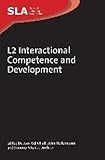L2 Interactional Competence and Development / ed. by Joan Kelly Hall, John Hellermann, Simona Pekarek Doehler.
Material type: TextSeries: Second Language AcquisitionPublisher: Bristol ; Blue Ridge Summit : Multilingual Matters, [2011]Copyright date: ©2011Description: 1 online resource (296 p.)Content type:
TextSeries: Second Language AcquisitionPublisher: Bristol ; Blue Ridge Summit : Multilingual Matters, [2011]Copyright date: ©2011Description: 1 online resource (296 p.)Content type: - 9781847694065
- 9781847694072
- Communicative competence
- Conversation analysis
- Second language acquisition -- Ability testing
- Second language acquisition
- LANGUAGE ARTS & DISCIPLINES / Linguistics / Psycholinguistics
- L2 competence
- L2 development
- SLA
- Second Language Acquisition
- conversation analysis
- interactional competence
- interactional competencies
- interactional development
- 407.1 22
- P118.2 .L18 2011
- P118.2 .L18 2011
- online - DeGruyter
| Item type | Current library | Call number | URL | Status | Notes | Barcode | |
|---|---|---|---|---|---|---|---|
 eBook
eBook
|
Biblioteca "Angelicum" Pont. Univ. S.Tommaso d'Aquino Nuvola online | online - DeGruyter (Browse shelf(Opens below)) | Online access | Not for loan (Accesso limitato) | Accesso per gli utenti autorizzati / Access for authorized users | (dgr)9781847694072 |
Frontmatter -- Contents -- Contributors -- Preface -- Chapter 1. L2 Interactional Competence and Development -- Part 1: The Nature of L2 Interactional Competence -- Chapter 2. Enacting Interactional Competence in Gaming Activities: Coproducing Talk with Virtual Others -- Chapter 3. Learning as Social Action -- Chapter 5. Second Language Interaction for Business and Learning -- Chapter 6. Responding to Questions and L2 Learner Interactional Competence during Language Proficiency Interviews: A Microanalytic Study with Pedagogical Implications -- Part 2: Development of L2 Interactional Competence -- Chapter 7. Members’ Methods, Members’ Competencies: Looking for Evidence of Language Learning in Longitudinal Investigations of Other-Initiated Repair -- Chapter 8. Achieving Recipient Design Longitudinally: Evidence from a Pharmacy Intern in Patient Consultations -- Chapter 9. Developing ‘Methods’ for Interaction: A Cross-Sectional Study of Disagreement Sequences in French L2 -- Chapter 10. Becoming the Teacher: Changing Participant Frameworks in International Teaching Assistant Discourse -- Appendix 1: Transcription Notations -- Appendix 2: Dialogic Lecture (D2) Instructions -- Appendix 3: Dialogic Lecture Evaluation Form
restricted access online access with authorization star
http://purl.org/coar/access_right/c_16ec
Drawing on data from a range of contexts, including classrooms, pharmacy consultations, tutoring sessions, and video-game playing, and a range of languages including English, German, French, Danish and Icelandic, the studies in this volume address challenges suggested by these questions: What kinds of interactional resources do L2 users draw on to participate competently and creatively in their L2 encounters? And how useful is conversation analysis in capturing the specific development of individuals’ interactional competencies in specific practices across time? Rather than treating participants in L2 interactions as deficient speakers, the book begins with the assumption that those who interact using a second language possess interactional competencies. The studies set out to identify what these competencies are and how they change across time. By doing so, they address some of the difficult and yet unresolved issues that arise when it comes to comparing actions or practices across different moments in time.
Mode of access: Internet via World Wide Web.
In English.
Description based on online resource; title from PDF title page (publisher's Web site, viewed 01. Dez 2022)


